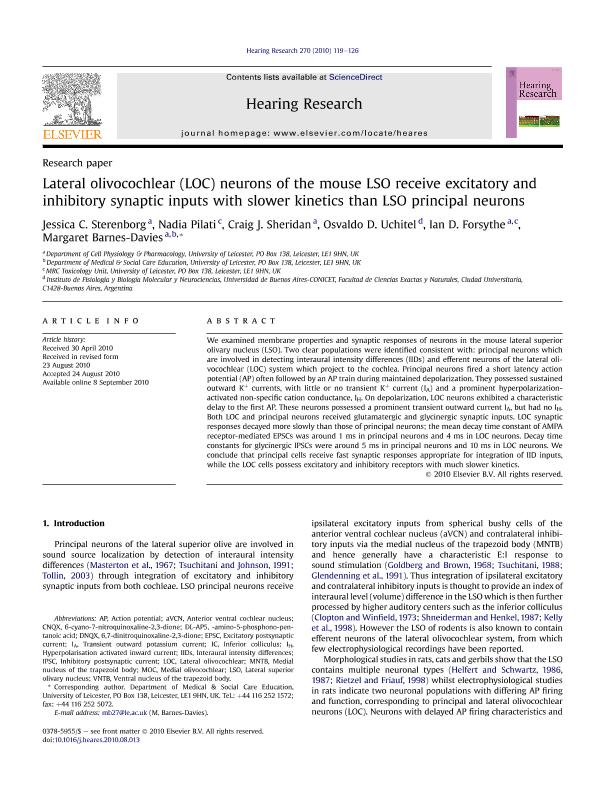Artículo
Lateral olivocochlear (LOC) neurons of the mouse LSO receive excitatory and inhibitory synaptic inputs with slower kinetics than LSO principal neurons
Sterenborg, Jessica C.; Pilati, Nadia; Sheridan, Craig J.; Uchitel, Osvaldo Daniel ; Forsythe, Ian D.; Barnes Davies, Margaret
; Forsythe, Ian D.; Barnes Davies, Margaret
 ; Forsythe, Ian D.; Barnes Davies, Margaret
; Forsythe, Ian D.; Barnes Davies, Margaret
Fecha de publicación:
08/2010
Editorial:
Elsevier Science
Revista:
Hearing Research
ISSN:
0378-5955
Idioma:
Inglés
Tipo de recurso:
Artículo publicado
Clasificación temática:
Resumen
We examined membrane properties and synaptic responses of neurons in the mouse lateral superior olivary nucleus (LSO). Two clear populations were identified consistent with: principal neurons which are involved in detecting interaural intensity differences (IIDs) and efferent neurons of the lateral olivocochlear (LOC) system which project to the cochlea. Principal neurons fired a short latency action potential (AP) often followed by an AP train during maintained depolarization. They possessed sustained outward K+ currents, with little or no transient K+ current (IA) and a prominent hyperpolarization-activated non-specific cation conductance, IH. On depolarization, LOC neurons exhibited a characteristic delay to the first AP. These neurons possessed a prominent transient outward current IA, but had no IH. Both LOC and principal neurons received glutamatergic and glycinergic synaptic inputs. LOC synaptic responses decayed more slowly than those of principal neurons; the mean decay time constant of AMPA receptor-mediated EPSCs was around 1 ms in principal neurons and 4 ms in LOC neurons. Decay time constants for glycinergic IPSCs were around 5 ms in principal neurons and 10 ms in LOC neurons. We conclude that principal cells receive fast synaptic responses appropriate for integration of IID inputs, while the LOC cells possess excitatory and inhibitory receptors with much slower kinetics.
Archivos asociados
Licencia
Identificadores
Colecciones
Articulos(IFIBYNE)
Articulos de INST.DE FISIOL., BIOL.MOLECULAR Y NEUROCIENCIAS
Articulos de INST.DE FISIOL., BIOL.MOLECULAR Y NEUROCIENCIAS
Citación
Sterenborg, Jessica C.; Pilati, Nadia; Sheridan, Craig J.; Uchitel, Osvaldo Daniel; Forsythe, Ian D.; et al.; Lateral olivocochlear (LOC) neurons of the mouse LSO receive excitatory and inhibitory synaptic inputs with slower kinetics than LSO principal neurons; Elsevier Science; Hearing Research; 270; 1-2; 8-2010; 119-126
Compartir
Altmétricas



